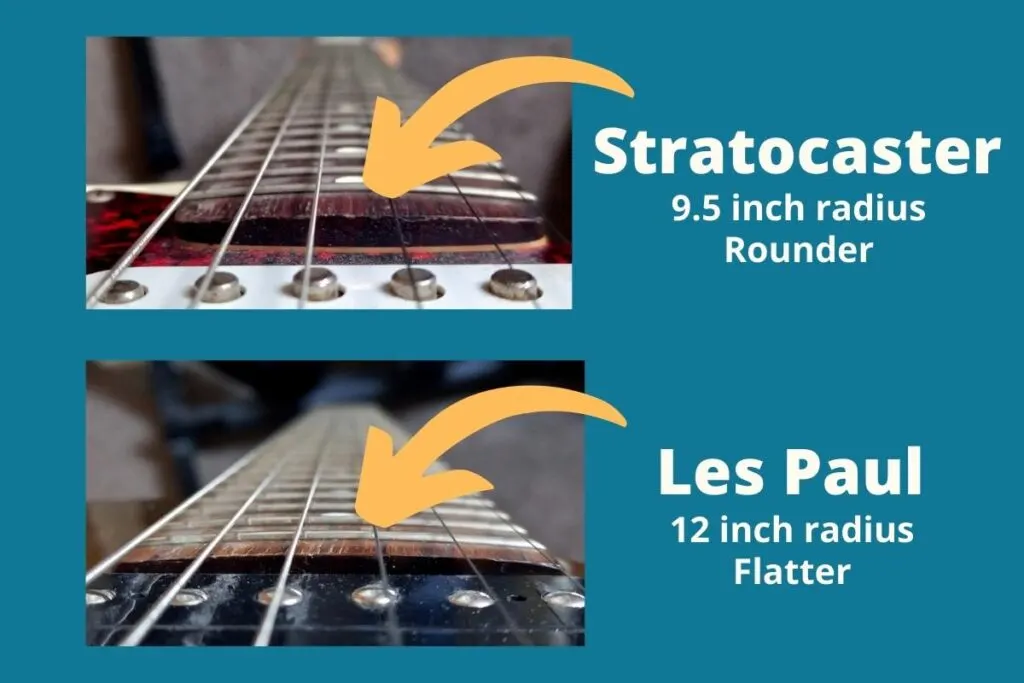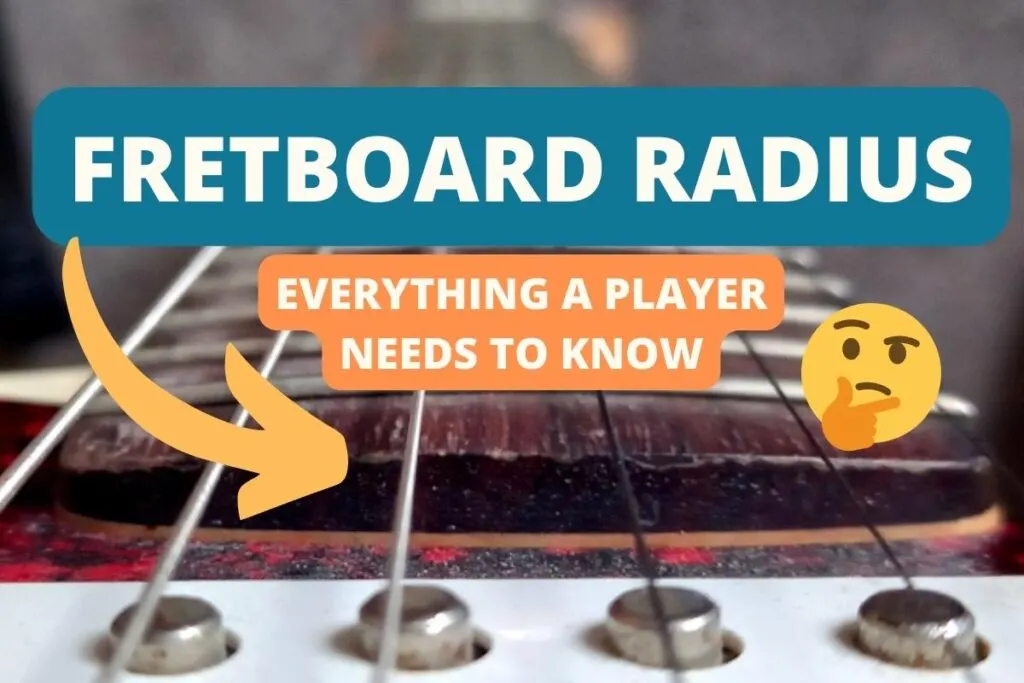We guitarists like to know every little detail about our guitars (or “soon-to-be-ours” guitars!). Fretboard radius is one of these details, and is something that’s shown in any guitar listing, but what does it mean?
Fretboard radius refers to the amount that a fretboard is curved, across its width. A fretboard with a small radius is more curved than one with a larger radius. Most electric guitars will have a radius of between 7.25 inches and 16 inches, with the most common being 9.5 inches.
In this article, I’ll give you all the info you need about fretboard’s radius, how it’s beneficial for specific playstyles, how to measure it, as well as which fretboard radius I think is best!
What is a fretboard radius?
The fretboard radius of a guitar or bass is the measurement of the curvature of the fretboard across its width, and is usually shown in inches (“).
Another way to look at it is to imagine your fretboard as the segment of a larger, invisible circle that surrounds the neck. The smaller the circle, the more curved the fretboard will be.

If this is all sounding a bit too much like math class, don’t worry! The only thing you really need to know is that a smaller fretboard radius will have more of a curve, and a larger radius will have less of a curve and therefore be flatter.
Fretboards have this curve to make playing more comfortable as it’s shaped to fit the curve of your hands. This means your hand will sit more naturally on the fretboard, making it easier for you to play.
Almost every electric guitar and bass will have a fretboard with some amount of curvature. The trick is finding what feels best for you and your playing style.
Does it affect the playability of guitar or bass?
Fretboard radius does affect the playability to some degree. If it didn’t, then all fretboards would probably use the same radius!
But, it’s much more about personal preference and what feels right for you. To tell you the truth, you can play any style of guitar using any fretboard radius.
People just have their own preferences, and you will probably have yours!
Generally speaking, a smaller radius (more curved) is viewed to be more comfortable for playing chords. On the other hand, larger radius necks (flatter) are meant to be easier for single note playing, bending, and shredding.

Some manufacturers also make guitar necks with what’s called a “compound radius” fretboard where the radius is smaller towards the headstock and gets larger towards the body (generally past the 12th fret).
This is designed to give you the “best of both” radii, by making playing chords more comfortable while also giving you a flatter fretboard higher up the fretboard where you’d usually solo.
From my perspective, fretboard radius really doesn’t make too much of a difference! I have several guitars that have different fretboard radii and I can go from one to the other without really noticing it.
I’ve bought all the guitars I own because I like how they feel to play. Part of that will be fretboard radius, but it’ll also be down to the neck profile, scale length, set-up… even the strings!
The important thing to take away from this is that you shouldn’t buy a guitar based on its radius alone. Buy it because it feels good to play!
Top tip: If you’re buying a guitar online, try it out in a local music shop first!
Does it affect the sound of the guitar or bass?
Fretboard radius itself doesn’t affect the sound of your guitar or bass, however, it might affect how well you can play the notes depending on what’s comfortable for your hand.
You should be able to comfortably press the strings against the fretboard with enough force to make the notes resonate. If you have a guitar with a radius that’s uncomfortable for you, then it’s likely that your hands will get tired quicker, and you’ll start making mistakes. And most importantly: it won’t be fun to play!
Again, neck profile and other factors will be a more important part of how the guitar feels in your hands, so don’t worry too much about fretboard radius as a stand-alone concept!
How do you measure fretboard radius?
Measuring the fretboard radius is pretty simple if you have the correct tools. The one needed for this job is something called a radius gauge.
Generally speaking though, it’s not something that you need to measure. A quick Google search, or a look in your guitar’s manual (if you still have it!), will tell you your guitar’s fretboard radius.
On a related note, your guitar strings should be set up to match the curvature of the fretboard. I covered how to do this in my article on how to fix fret buzz.
What’s the most common fretboard radius?
Typically, the fretboard radius of electric guitars is between 7.25 inches and 16 inches. The most common and widely used radius is 9.5 inches (241mm), which is most often found on Fender model guitars.
Prior to the 1980s, the most commonly used radius was 7.25 inches, which is now mostly found on vintage and reissue models of guitars.
For quick reference, here’s a table showing some common guitar models and their radii. As a general rule, I’ve found that Gibson guitars tend to have a larger fretboard radius than Fender guitars.
Radius size chart of popular guitar models
| Guitar Model | Fretboard Radius (Inches) |
|---|---|
| Gibson Les Paul Standard 2013Gibson Les Paul Vintage | Compound 10 – 16 inches12 inches |
| Fender Stratocaster ModernFender Stratocaster Vintage | 9.5 inches7.25 inches |
| Fender Precision Bass | 9.5 inches |
| Fender Telecaster Deluxe Series | 12 inches |
| Gibson Thunderbird | 12 inches |
| Gibson ES-335 | 12 inches |
| Gibson SG Standard | 12 inches |
| Fender Jazz Bass | 9.5 inches |
| Fender Mustang | 9.5 inches |
So, which fretboard radius is the best?
It feels like a non-answer, but there truly is no “best” fretboard radius. Everybody has different shaped hands and fingers and everyone will have their own preferences.
The best fretboard radius is the one that you find most comfortable in your hands.
Personally, I’ve found that a 9.5” fretboard radius on my Fender Stratocaster is comfortable for me for long playing sessions. But my Les Paul, which has a 12” radius, is also just as comfortable! While I can tell there’s a difference (if I’m really looking at it), it really doesn’t affect my playing style all that much.
However, it may be that you personally might find some techniques more manageable to play than others, due to the curvature of the fretboard.
If you’re considering a particular size fretboard radius because of the type of music you play, then there are some factors you can take into consideration.
Remember, though, that this is just a guide. There are many other factors like the shape of your hand, fingers, and the guitar’s neck (to name a few!) that will affect which fretboard radius is best for you.
Best for beginners
Beginners tend to start learning open position chords and scales, so a radius of 9.5 to 10-inches should be considered. This has more curvature, so it’ll mean less strain on your hands for long practice sessions.
Best for fingerstyle
Fingerstyle players usually prefer a flatter fretboard. This is because it’s similar to acoustic and classical guitars, which use completely flat fretboards.
I’d say anything between 12 to 16-inches will work well if you’re coming from an acoustic background and want something that feels familiar.
Best for small hands
Individuals who tend to have smaller hands usually prefer to play on a flatter radius. So, I’d say a radius of 12 inches or higher would be your best bet.
Conclusion: Does fretboard radius really matter?
So, at the end of the day, is fretboard radius important? Well, it does play some role in your hands comfort and being able to fret notes properly, which is what guitar is all about. But it’s certainly not the only factor affecting how your guitar feels to play.
Personally, I wouldn’t worry about fretboard radius too much. I’ve been playing guitar for over 15 years and over that time I’ve played many different guitars with different radii, and they’ve all been playable! (and in most cases, I didn’t even know what the radius was, just that it felt good to play!).
If you’re a beginner, or are looking for your next guitar, my recommendation would be to go out and test guitars with different-sized fretboard radii, different shapes of neck, and different models and see what you like and what works for you, because that’s the only thing that really matters.


Conor is a music producer, multi-instrumentalist, and all-round enthusiast from the UK with over 15 years of experience. He’s the founder and sole-content creator for the roundtable audio blog and YouTube channel.
